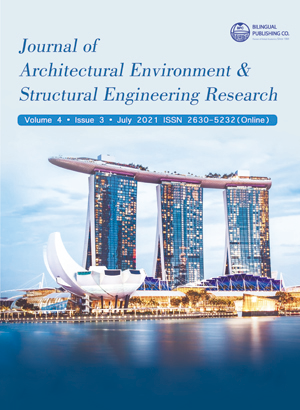-
2128
-
1862
-
1638
-
1600
-
1527
Building Pattern Technique of an Indigenous Community – Does Its Appearances a Distinctive Representation?
DOI:
https://doi.org/10.30564/jaeser.v4i3.3385Abstract
Bangladesh is enriched with beautiful traditional indigenous cultures. Different indigenous peoples with their distinctive existences also considerably create an enhance values and lifestyles to the socio-cultural sectors of Bangladesh [1]. Habitually, these indigenous communities have been comparable to live a large combined family to shear their lifestyles [2]. Presently the country has 45 indigenous communities who are living in different locations. All indigenous people within this country have their own style to build their settlements with special techniques to keep them safe and sound from all types of natural and environmental vulnerabilities and also enhance their knowledge of construction techniques and lifestyle. Rakhain is one of them with very small number of people are still living in different regions within the country which have their own system of building techniques. Study found that for several hundreds of years Rakhains are strictly following their indigenous prescription of house and settlement pattern. Although like other indigenous people of this country, they have mountains of problems, such as forced land occupation, lack of security and minority characteristics. Above all, forced political separation has gradually drowned them in the abysmal pit of marginal destiny. This has turned them into exiles in their own land. As a result, many of them are being forced to leave the country and as a result they misplaced their native knowledge and technique to construct. Thus, this study will initially focus on to search for the distinctiveness of their settlement pattern and building construction techniques and lifestyle. Again, in view of their problems, knowledge and experiences concerning archetype, built and house pattern, this study will finally explain how Rakhains accumulate their every distinctiveness from history and for present and future invention.
Keywords:
Rakhaine, House Pattern, Indigenous, Settlement Pattern, Distinctiveness.References
[1] Barman C. and Chakma P. (2010), Human Rights Report 2009-2010 on Indigenous Peoples in Bangladesh, Kapaeeng Foundation.
[2] Roza, F. (2020),”Indigenous People of Bangladesh: Barrier and How to Overcome the Barriers”, Department of Management Studies, Faculty of Business Studies, Bangladesh University of Professionals.
[3] Smith M., (2019), Arakan (Rakhine State) A Land in Conflict on Myanmar’s Western Frontier, Transnational Institute (tni), De Wittenstraat 25, 1052 AK Amsterdam, The Netherlands.
[4] Mustafa M. (2005), The Rakhaines: Aborigines in Bangladesh. Dhaka: Mowla Brothers.
[5] Cho, V. (2017), Ethnicity and Identity, Routledge Handbook of Contemporary Myanmar, 1st Edition, eBook ISBN9781315743677, Pages – 9.
[6] Khaing, T. S. (1995), The Rakhaing Tanzaung Magazine, No, 18.
[7] Aung C. T. (2008), The problem facing past culture of Rakhain tribal; Published by Maung Mang Nine (Maung Mang), 1st edition.
[8] Tun O. S. (2005), Thongran and Rakhine culture, The Rakhaing Review 4, Pp: 63-64.
[9] Ashadul I. (2013), Changing Rakhaine Adivasi Culture of Bangladesh: A study Of the Birth, Death and Marriage ritual.
[10] Hall E. D. G. (1964), A History of South-East Asia, Published: Macmillan; St. Martin’s P.
[11] Mohsin A. (2000), A State of Minority Rights in Bangladesh, Journal for International Center for Ethnic Studies, Colombo, Vol. 4, No. 3&4.
[12] Aung M. B. (2008), Nga Ro Rakhaing; Publish by Maung Mang Nine (Maung Mang); 1st edition, Pp: 107.
[13] Mohajan and Haradhan, (2018), History of Rakhine State and the Origin of the Rohingya Muslims, Premier University, Chittagong, Bangladesh, MPRA Paper No. 88186, posted 28 Jul 2018 13:24 UTC.
[14] Baird R. (2008), The Impact of Climate Change on Minorities and Indigenous Peoples, Minority Rights Group International, 54 Commercial Street, London E1 6LT, United Kingdom, ISBN 978-1-904584-75-9.
[15] Khaing T. S. (1994), Rakhaine Mahamuni Phara Tha-hmaing (in Rakhaine), ed.1, 3d-1991, Rangoon, Burma, Pp:14; Quoted: Maung Than Aye, ‘Identities of the Rakhaing Community’, The Rakhaing, Vol.1.
[16] Islam S., Rahman M., Hasan T.M., Mowla Q.A. (2016), A Study on the Settlement Morphology of Indigenous Khasi Community in Sylhet, Bangladesh, PRATNATATTVA; Journal of The Department of Archaeology, Jahangir Nagar University, Vol. 21. No.1.
[17] Chowdhury S., Saha K. (2012), Indigenous Housing and Settlement Pattern of Patro (Laleng) Community in Sylhet, International Journal of Engineering and Innovative Technology (IJEIT), Volume 2, Issue 6, Pp: 202-206.
Downloads
How to Cite
Issue
Article Type
License
Copyright © 2021 Md. Mustafizur Rahman,Mohammad Tanvir Hasan,Shahidul Islam,Jiaul Hassan Mithun

This is an open access article under the Creative Commons Attribution-NonCommercial 4.0 International (CC BY-NC 4.0) License.




 Md. Mustafizur Rahman
Md. Mustafizur Rahman





